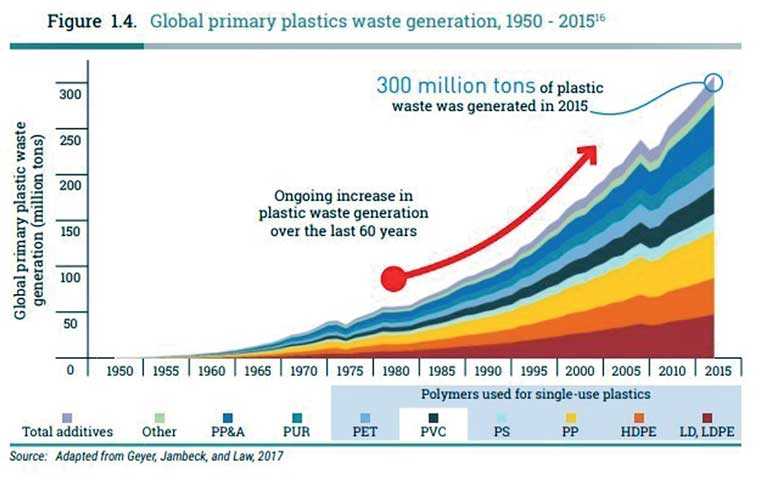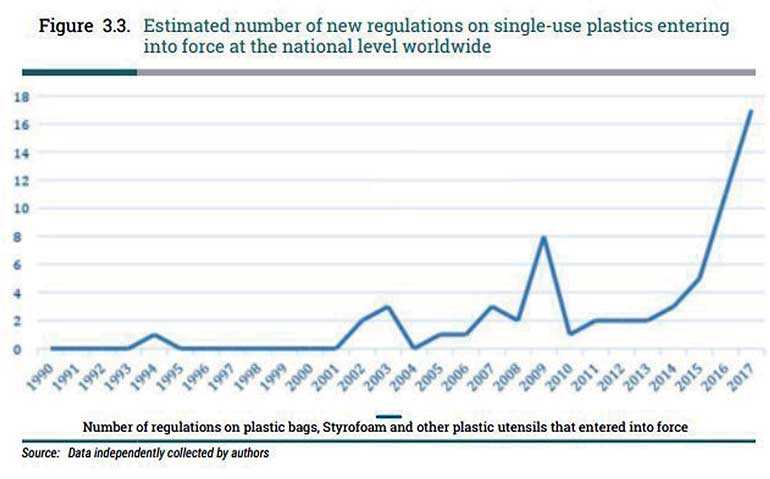Saturday Apr 19, 2025
Saturday Apr 19, 2025
Monday, 22 April 2019 00:00 - - {{hitsCtrl.values.hits}}

History and current situation
Since the revolutionary invention of the first synthetic polymer back in 1869 by John Wesley Hyatt, plastic manufacture has not been constrained by the limits of nature. The wide range of completely synthetic modern plastics started to be developed around a century ago, offering benefits not found in natural materials. With the countless possibilities of plastics, it was viewed as an abundant material that is inexpensive and safe, which could be shaped by humans to their desire.
Over the last 50 years, plastics have saturated our world, and at present play an important part in our day to day activities. It is cheap to produce, convenient, useful, durable, and found everywhere. This miracle material has made modern life convenient, at a very high cost of course, in terms of the environment, and has become a serious global menace. More than 40% of it is used just once, leading to plastic pollution, choking waterways and causing harm to many living beings in numerous ways. Single-use or disposable plastics such as plastic bags, straws, PET bottles and most food packaging, have an immense impact on the environment. These persist in the environment, degrading the soil and disturbing natural cycles.
The perfect optimistic image of plastics did not last for long, as signs of negative impacts emerged with the persistence of plastic waste, raising concerns about pollution. Plastic debris in the oceans were first observed in the 1960s, a decade in which people in developed countries became increasingly aware of environmental problems. The anxiety about waste increased, as it was realized that plastic lasts forever in the environment. The reputation of plastics was lowered further, due to growing concern about the potential threat to human health from additives used in the plastic manufacturing process. These chemicals leach out to our food and water, and get accumulated in organisms, thereby affecting the health and wellbeing of future generations.
The ultimate symbol of the issue of plastic waste is the Great Pacific Garbage Patch, the largest accumulation of ocean plastic in the world, which covers an estimated surface area of 1.6 million square kilometres with a mass of approximately 80,000 metric tonnes. Much of the debris found in this garbage patch floating in the Pacific Ocean, comprise micro plastics, smaller than 5mm in size, suspended throughout the water column. Micro plastics are very difficult to remove and are often mistaken for food by marine animals. Ocean plastic is estimated to kill millions of marine animals every year, affecting nearly 700 species, including endangered ones; some are harmed visibly - strangled by abandoned fishing nets or discarded six-pack rings. Akin to the Great Pacific Garbage Patch, is the Indian Ocean Garbage Patch which was discovered in 2010. Its actual size is unknown as its borders remain dynamic and cannot be identified as a solid island of plastic. However estimates of its size range between 2 million to 5 million square kilometres and is heavily influenced by the monsoons which are unique to this region of world. Here too, micro plastics have been identified as the most prevalent material and is thought to originate from the countries that surround the Indian Ocean.
In the 1980s, the plastic industry offered recycling as a solution, encouraging municipalities to collect and process recyclable materials as part of their waste management systems. However, it has not proved to be a great way to mitigate this serious issue and most plastics still end up in landfills or in the environment.
Alarming statistics
Despite the grave menace it has become, modern life is clearly not possible without plastic. Hence scientists are attempting to make plastics safer and more sustainable. Innovators are working on developing bioplastics, which are made from plant crops instead of fossil fuels, to create substances that are more environmentally friendly, and to make plastics that are truly biodegradable, while also searching for ways to make recycling more efficient, and to find a process that converts plastics back into the fossil fuels from which they were derived. It is realized that plastic is not perfect but significant and necessary for our future.
Global action against plastic pollution
Global initiatives to reduce or eliminate the consumption of single-use plastics have been gaining momentum. The UN Environment Program’s 2018 report – ‘Single-use Plastics: A Road Map for Sustainability’ - finds that the bulk of the action being taken is concentrated around the use of single-use plastics.
Governments from around the world committed to the vision of a ‘Pollution Free Planet’, and a resolution arrived at, at the United Nations 3rd Environment Assembly, specifically addresses marine litter and micro plastics, and encourages member states to reduce unnecessary plastic use and promote the use of environmentally sound alternatives while prioritizing policies to reduce the amount of plastics entering the marine environment.
Africa stands out as the continent where the largest number of countries (25) instituted a total ban on the production and use of plastic bags. In Asia, several countries have attempted to control the manufacture and use of plastic bags through levies, and some governments already introduced plastic bag bans more than a decade ago, such as in Bangladesh. Nonetheless, the enforcement of regulations has often been poor. The European Union put forth a directive in 2015, encouraging member states to set reduction targets or adopt economic instruments to achieve a sustained reduction of ‘lightweight’ carrier bags. As such, countries choose measures ranging from bans, such as in Italy and France, to agreements with the private sector, as in Austria.
With regards to Oceania, most of the states in Australia have banned lightweight plastic bags and in Papua New Guinea, non-biodegradable plastic bags are banned. In Central and South America, regulations to curb the consumption of plastic bags are in place at both the national and subnational levels, and countries such as Haiti and Costa Rica also regulate the use of foamed plastic products. Costa Rica in particular, aims to become the first country in the world to eliminate single-use plastics by 2021. In North America, regulations have been introduced mostly at the state or city level. Lightweight plastic bags are banned, for example in Montreal (Canada) and California and Hawaii (USA). Action against single-use Styrofoam products has been taken in New York City, which re-instated in 2017 its ban on single-use Styrofoam containers after a first attempt in 2015.

Where Sri Lanka stands
The plastic menace is not an issue where the solution is not known. We all are aware of proper disposal of garbage, and it can be done by anyone. It is the responsibility of each person using plastics to take action in their capacity to minimize the magnitude of this issue. With the right policies and regulations in place, it is a matter of ensuring implementation by strengthening the relevant authorities and systems, to take action as a nation to overcome this challenge. Sri Lanka banned the import, sale, and use of polyethylene bags <20 microns and Styrofoam containers in 2017. However, the implementation and monitoring of this ban has not been adequate and was met with a number of oppositions by the industrial sector, requesting for a more phased and practical solution to be adopted within a given time period.
Our collective response
The Municipal Waste Recycling Program (MWRP) is aimed at reducing plastic pollution of the oceans in four countries, namely Indonesia, Philippines, Sri Lanka, and Vietnam. The program supports non-governmental partners, such as civil society organizations, youth-led or women-led organizations, private sector companies, associations, cooperatives, and academic institutions that can implement municipal waste recycling solutions with a focus on reducing plastic pollution of the marine environment. It is administered by the Development Innovations Group (DIG) on behalf of the United States Agency for International Development (USAID).
The Ceylon Chamber of Commerce (CCC) together with Biodiversity Sri Lanka (BSL), and with the official endorsement of the Ministry of Mahaweli Development and Environment and with the financial assistance of the MWRP, is implementing a project to develop an Extended Producer Responsibility (EPR) mechanism for the recycling of post-consumer plastics. The main objective of the project is to provide essential “technical and advisory capacity support for a circular economy for post-consumer plastic recycling and management” to minimize plastic loadings to the coastal and marine environment. Further, this project will focus on improving the enabling environment and building the capacity of stakeholder entities, to put in place a post-consumer plastic management system in the country, in a systematic manner with the participation of all related stakeholders.
This project was launched in October, 2018 and it has established a Project Steering Committee representing all relevant stakeholders including the Government Sector and the Private Sector, as well as key associations dealing with polythene and plastic production and recycling in Sri Lanka, to provide strategic direction and to facilitate the process of establishing an EPR Policy in Sri Lanka. The project has had a series of consultations with key Government Agencies responsible for waste management as well as private sector organizations to obtain their initial inputs for formulation of an EPR mechanism acceptable to all stakeholders.
The project has commissioned a Market and Socio-Economic Study which will generate essential country-specific information on plastic use and potential for application of circular economic principles in Sri Lanka, for science-based, economically sound, decision making. The project is due to complete in September 2020 and will hopefully deliver a practical and effective EPR Roadmap with a public-private-partnership approach for adoption by all stakeholders responsible for this issue.
Article contains extracts from the UN Environment Program’s 2018 report – ‘Single-use Plastics: A Road Map for Sustainability’
Images courtesy of www.weforum.org